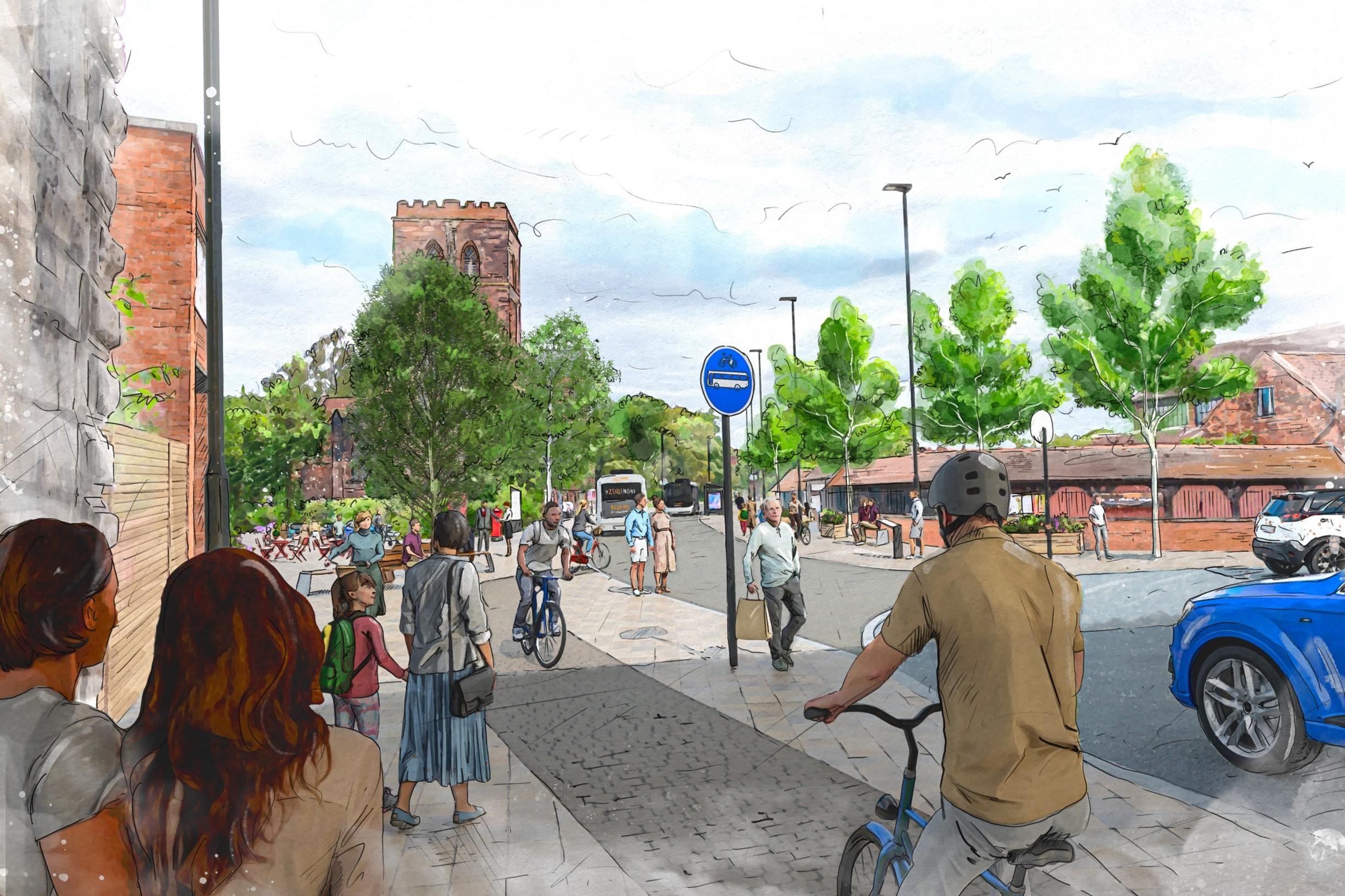

A new strategy to improve Shrewsbury town centre includes plans to reduce through-traffic, increase priority for buses, pedestrians and cyclists, cut parking capacity and create a climate resilient area.
The 10-year vision has been developed by Shrewsbury Big Town Plan Partnership, made up of Shropshire Council, Shrewsbury Town Council and Shrewsbury Business Improvement District (BID).
A Movement and Public Space Strategy has been undertaken by transport planning and design consultancy PJA. It has taken feedback from previous consultations on the Big Town Plan and Shrewsbury Masterplan Vision, alongside detailed engagement work and research, to suggest a range of interventions for changing and improving travel and movement in and around the town.
As part of the vision, a two-way bus corridor would be introduced through the town centre making buses quicker and easier to use, said the partnership.
Parking tariffs would be revised to make it far cheaper to use car parks on the edge of the town centre while the Park & Ride service would be extended and improved, along with more public bus services.
Under the proposals, traffic loops would be installed to reduce the amount of traffic driving through the town centre. This would involve expanding the current ‘Pedestrian Priority Zone’ on Pride Hill, meaning that no motor vehicles, unless exempt, would be permitted in this zone.
Vehicles would not be allowed to enter the Pedestrian Priority Zone between 10am and 4pm.
The Shrewsbury Big Town Plan Partnership said: “Implementing the traffic loop system would also generate opportunities to enhance streets across the town centre for pedestrians, as traffic volumes would be lower making it more pleasant for walking and cycling and allow new public spaces to be created at the boundaries between traffic loops.”
Over time, some trips will transfer to walking, cycling and public transport, as these modes become more attractive, the partnership said. “Remaining vehicle trips, unless exempt, would need to re-assign onto alternative routes, however it should be noted that some of these trips may not be made, or be undertaken to a different destination or at a different time of day. This is a phenomenon known as ‘traffic evaporation’ or ‘disappearing traffic’. ”
Traffic within the Pedestrian Priority Zone would be restricted by ‘modal filters’, which could either be physical barriers or controlled through Automatic Number Plate Recognition (ANPR).
Steps would be taken to discourage people from parking in the town centre by increasing tariffs. Currently, over 2,000 car parking spaces are provided within Shropshire Council owned car parks in the town centre and on the edge of the river loop. “Depending on the number of vehicle occupants and length of stay, car parking is also relatively cheap compared to taking public transport, which encourages more people to drive into the town centre,” said the partnership.
“Therefore, as a general principle, parking charges across Shrewsbury would be adapted as part of the Strategy, with highest parking charges would continue to be located within the river loop, decreasing in price as you move further away.”
The strategy seeks to ensure that access is provided for everyone, including people with disabilities.
Funding would come from Shropshire Council and developer contributions, and bids would be submitted for regional or national funds from the Government. “These funds are typically ringfenced for particular types of schemes, such as walking, cycling, public transport and road safety schemes, and are often limited to specific time frames for preparing bid submissions and delivering the project,” said the partnership.
Shropshire Council said the plan would contribute towards its aim of achieving carbon net neutral targets by 2030.
“We expect more people to travel around Shrewsbury on foot, by cycle, or by public transport, reducing the number of trips made by car, resulting in a reduction in carbon dioxide emissions.”
Another aim of the strategy is to positively impact the town's resilience to extreme weather events, with trees, shrubbery, and other vegetation planted across the town. “This not only enhances the town's visual appeal but also serves the dual purpose of effectively managing high volumes of rainwater. This approach reduces surface water run-off, helping to ensure continued accessibility to the town centre during flood events.”
Shrewsbury Movement and Public Space Strategy
TransportXtra is part of Landor LINKS
© 2025 TransportXtra | Landor LINKS Ltd | All Rights Reserved
Subscriptions, Magazines & Online Access Enquires
[Frequently Asked Questions]
Email: subs.ltt@landor.co.uk | Tel: +44 (0) 20 7091 7959
Shop & Accounts Enquires
Email: accounts@landor.co.uk | Tel: +44 (0) 20 7091 7855
Advertising Sales & Recruitment Enquires
Email: daniel@landor.co.uk | Tel: +44 (0) 20 7091 7861
Events & Conference Enquires
Email: conferences@landor.co.uk | Tel: +44 (0) 20 7091 7865
Press Releases & Editorial Enquires
Email: info@transportxtra.com | Tel: +44 (0) 20 7091 7875
Privacy Policy | Terms and Conditions | Advertise
Web design london by Brainiac Media 2020